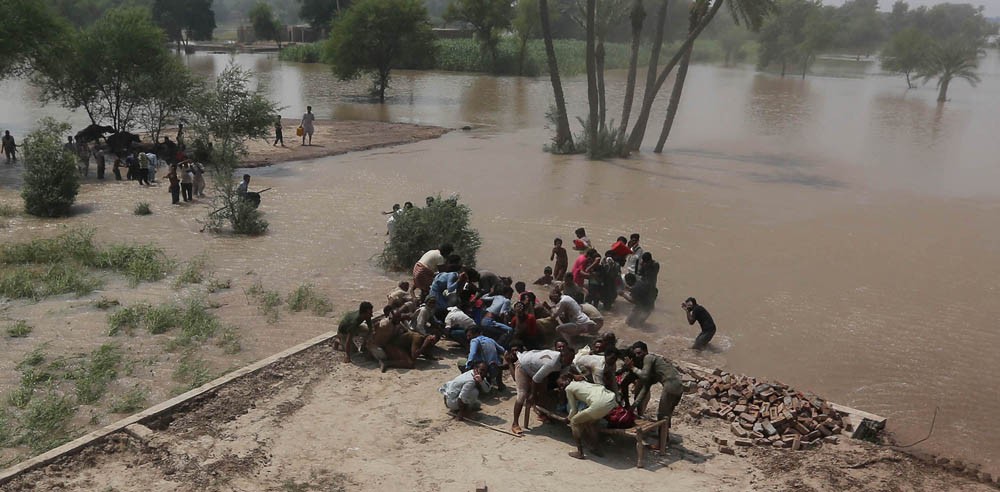
The level of government preparedness and response greatly determines the extent of suffering of affected populations

Floods in Pakistan have assumed a cyclic pattern since 2010, thus turning it into an annual catastrophe. Monsoon is a recurring phenomenon in Pakistan yet the devastating effects of ongoing 2014 flood show that nothing substantial has been done so far to control this massive destruction in first place.
The flood continued engulfing thousands of acres of productive lands, habitats, livestock, and infrastructure of Punjab. More than 200 people have lost their lives in Northern Punjab as a result of flashfloods and there is no let up in the number of people getting injured.
This chaos seems like a never-ending storm of unfortunate events as the flood water has entered Sindh causing more damage to crops and assets. These episodes are usually followed by aid appeal to international community and humanitarian organisations. How long will it go?
Incentives such as international aid greatly help prevention, mitigation, and damage of natural disasters, even if they can’t affect the likelihood of rainfall in a specific area or seismic activity along a particular fault line. There is no controversy in it as there are political dimension of disaster prevention and this is evident from the current scenario of Pakistan.
Our government and flood management departments have always been more focused in the rectification of the after-effects of flood disaster rather than drafting rationale and effective medium and long-term strategies to at least mitigate its effects -- even though the meteorological department has forecast heavy monsoon rains with the warning that high levels of flooding may be expected this year.
As predicted, devastating floods hit Punjab leaving many stranded and without food. Further downstream, more than 214,000 people have been evacuated from the affected areas so far, according to National Disaster Management Authority.
The severity of damage raises many basic questions about the country’s resource and flood management strategies -- if there exist any. This explains two things; either the elected government is trying its very best to rationally deal with the problem or merely prolonging the matter for bringing in international aid and free relief in the country.
This brings attention to the fact that natural disaster, whether it is flood or earthquake, occurs in a political space. These calamities are not driven by politics yet they are not totally immune from the political sphere, particularly in developing countries like Pakistan. Although events beyond our control trigger a disaster but the level of government preparedness and response greatly determines the extent of suffering incurred by affected population.
Around the world, there are some governments like United States of America, European Industrialised countries and Asian Industrialised countries prepare well to cope with flood disaster while others like Pakistan and India doesn’t. The presence of international aid increases the chances that the government will under-invest to attract foreign aid.
This opens another Pandora’s box that by bringing free relief to countries afflicted by natural disasters, international relief organisations, in a way, effectively reward bad behaviour on the part of the poor countries’ governments.
Our government care about the social welfare of its citizens but they also want to maximise government’s influence. Therefore, every year our elected government may use floods to redistribute power through the political effect, favouring disaster spending in regions that are politically aligned with the party in power.
The addition of humanitarian aid in this situation produces a bailout effect for our government as they may under-invest in disaster prevention when they are sure they will be bailed out in the event of disaster.
International organisations are sometimes accused of tolerating higher levels of misappropriations to deliver urgently needed aid.
These have policy implications for reducing the severity of natural disasters. First, the international humanitarian community must be involved in disaster prevention if it is to offer free relief. Second, whenever possible, flood relief should be provided locally so as to reduce the significance of the racket and political effects on the central government.
Third, political development, in the form of more responsive governments, will reduce the severity of disasters. Fourth, in particularly problematic areas, governments can be given extra payments for proper disaster preparation, including establishing and enforcing efficient regulations.
The presence of international humanitarian organisations dedicated to the alleviations of sufferings has a dramatic effect on the character, form, and amount of disaster spending in developing countries. In Pakistan, disasters particularly floods, have been used as a blunt policy instrument to target or reward populations and to help a government so that the calamity can be mitigated with outside effort.
Instead of just focusing on international relief, our governments should invest in prevention and decentralise flood relief mechanism.